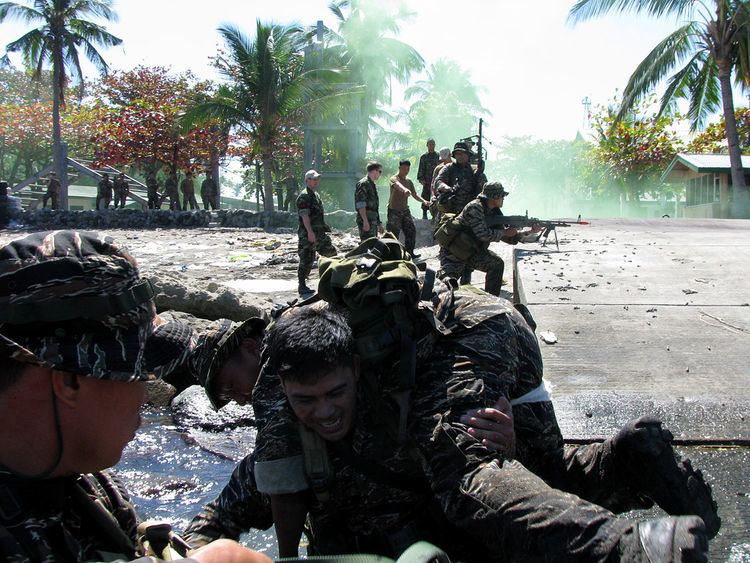Type Naval base Condition Active Event 1872 Cavite mutiny | Area 9 hectares (22 acres) Open tothe public No Built late 16th century | |
 | ||
Garrisons Naval Sea Systems Command, Naval Logistics Center | ||
Naval Station Pascual Ledesma, also known as Cavite Naval Base or Cavite Navy Yard, is a military installation of the Philippine Navy in Cavite City in the Province of Cavite. The 9-hectare (22-acre) naval base is located at the easternmost end of Cavite Point in the San Roque district (specifically Fort San Felipe) of the city. It was the former U.S. Naval Station Sangley Point, transferred to the Philippines in 1971. In 2009 it was named after Cmdre. Pascual Ledesma (b. May 17, 1843 – d. June 6, 1917), a leader of the Philippine revolution and the first Officer-In-Command of the Philippine Navy.
Contents
History
The port town of Cavite Nuevo was established after the Spanish colonizers found that the deep waters around the tip of Cavite Point (Cavite la Punta) are suitable for large ships and established the Astillero de Rivera (Rivera Shipyard). Cavite City became the main seaport of the City of Manila and the staging port for the Manila-Acapulco Galleon Trade. After the demise of the galleon trade, the shipyard became the Spanish Arsenal.
American colonial period
When the sovereignty of the Philippines was ceded to the Americans after the Spanish–American War, the U.S. took over all the military stations left by the Spaniards including the Cavite Naval Yard. The American made several modifications and improvements, but also included the demolition of Fort Guadalupe and partially of Fort San Felipe.
In 1941, the 16th Naval District was established in the navy yard during the American colonial period. It is the same place the Japanese forces used as a headquarters after they conquered Cavite during the Second World War.
After independence
Early in December 1970, it was officially announced that U.S. Naval Station Sangley Point would be closed. On July 1, 1971, Sangley Point changed status from active to inactive in preparation for the turnover of the facility to the government of the Philippines. On-the-job-training sessions were conducted for Philippine naval personnel to ensure the safe and proper operation of all base industrial facilities.On September 1, 1971, the base was officially turned over to the government of the Philippines, ending 73 years as a U.S. Naval facility. It is currently used as a facility of the Philippine Navy and the Philippine Air Force. William J. Mitzel and his wife Barbara were the last US personnel to occupy quarters on the installation. Mr. Mitzel was responsible for the final turn over and lived on the installation with his wife, when the turn over was completed.
In line with Philippine Navy General Order number 229 dated July 7, 2009, the naval installations were renamed to honor esteemed predecessors in the military/naval service who fought for the protection of the nation's sovereignty, territorial integrity, democracy, and the maritime interests of the country. With this, the Naval Base Cavite, the naval station in Fort San Felipe, was assigned the name Naval Station Pascual Ledesma.
Naval Base Cavite provides support services to the Philippine Navy and other Armed Forces of the Philippines (AFP) tenant units in the base complex, such as refueling, re-watering, shore power connections, berthing, ferry services, tugboat assistance, sludge disposal services and housing.
Naval Sea Systems Command (NSSC)
Formerly the Naval Support Command (NASCOM), the Naval Sea System Command operates the country's military shipyards providing repair and maintenance of all Navy ships and aircraft and their weapons. They develop new technologies for the Navy and maintains their communications and electronic equipment in order to sustain the naval defense capability of the Philippine Navy. It is the biggest industrial complex of the Armed Forces of the Philippines (AFP).
Naval Logistics Center (NLC)
NLC began as the OSP supply center under the finance branch of the Philippine Army for supporting the few vessels turned over by the US Navy. In October 1947, the supply center was elevated to a regular division and paved the way to the establishment of the general supply depot named as the Naval Supply Center in 1950. It was placed under control of the Commander, Naval Shore Establishment, later called the Fleet Support Command and the Naval Support Command in 1967.
It is now called the Naval Logistics Center. The depot procures and maintains, manages supplies and raw materials, operates equipment and facilities and render related services in support of the logistics requirement of Philippine Navy units.
Hospital
Located within the base is the Cavite Naval Hospital, a medical facility that provides hospital and out-patient services to Philippine Navy personnel and their dependents. It is located on P. Zamora Extension/Reynoso Road,(14°28′58.6″N 120°54′52.5″E) adjacent to the navy chapel. The other naval hospital, Manila Navy Hospital is located in Fort Bonifacio in Taguig City, Metro Manila.
Chapel
Naval Base Cavite is served by the Stella Maris Chapel, a Roman Catholic military chaplaincy located on P. Zamora Ext. (or Reynoso Rd)(14°28′59.3″N 120°54′50.4″E) inside the base in Fort San Felipe, Cavite City.
